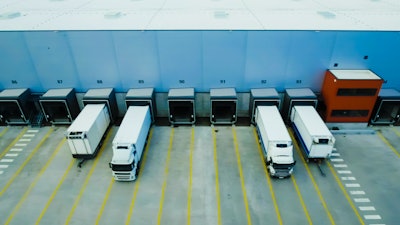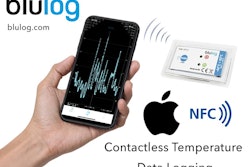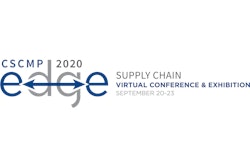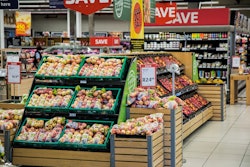
There are many facets to a resilient supply chain—stringent operational processes, enhanced supplier sourcing, strong company relationships and the drive to conduct business in the most ethical way possible at all times.
But, when a global pandemic such as the Coronavirus disease (COVID-19) hits, even the most resilient supply chains become challenged in ways never imagined.
For instance, imports at major U.S. retail container ports are expected to remain significantly below last year’s levels into the fall as the impact of the COVID-19 pandemic continues, according to the monthly Global Port Tracker report released by the National Retail Federation and Hackett Associates.
The online grocery market stole the spotlight from brick-and-mortar stores, surging at a 23% CAGR, as outlined in a study from Future Market Insights.
The consumer confidence index dropped 18.1 points in early April; March saw an 11.9-point decline, according to the 31st annual State of Logistics Report produced by the Council of Supply Chain Management Professionals (CSCMP).
And, 32% of consumers surveyed in NPD Group’s NET COVID-19 Pantry & Food Strategy Tracker are still experiencing out-of-stocks months after the COVID-19 outbreak began.
Case in point: COVID-19 has been more economically damaging than a standard recession or an escalation of trade tensions, says the CSCMP report.
So, what does this mean for the future of supply chains? What does this say about cold chains pre-COVID-19? Were U.S. cold food chains really underscoring honesty, consistency and accuracy, enough to at least survive a global pandemic?
That’s why, for a cold food supply chain to enforce integrity, it must incorporate blockchain, traceability, visibility, safer supplier sourcing, food safety and collaboration.
Companies must re-tool, regroup and invest in technologies designed to enhance the way product moves along the cold chain.
For many, the actions taken today set the precedence for how cold chains will recover tomorrow.
Food supply chain hit hard
The food supply chain was one of the hardest-hit segments by COVID-19, and is expected to lead to acute shortages of certain product categories, according to Quantzig supply chain analytics experts.
Most of the U.S. meat processors depend on spreadsheets that do not offer any real-time insights, says Quantzig experts. Since these meat products are highly perishable, meat supply chain managers need complete visibility on supply chain operations to make the right decision.
But then, as the pandemic hit, “customer buying habits caused demand for additional frozen foods to grow even more. The protein areas were hit the hardest, as employee health issues at process plants and uncertainly with export shipments created considerable disruption. This made for a very unstable and somewhat unpredictable flow of material in and out of operations and limited ability to manage inventory levels and speed-to-market,” says Bernard Biolchini, chief executive officer for Dematic Americas.
Plus, the temporary closure of meat processing plants further disrupted the meat supply chain, causing severe shortages of meat and poultry across the United States.
“The meat processing plants in the U.S. were already facing tremendous pressures due to the complex production environments and changing consumer demands,” according to Quantzig’s supply chain analytics experts. “To stay ahead of competitors, the meat processing firms must focus on developing strategies for smart planning and ensuring customer loyalty.”
Furthermore, inadequate cross-functional visibility of supply chain operations often resulted in unfulfilled orders and scarcity of raw materials.
“The largest impact of COVID-19 is the attention it has drawn to the fragility of supply chains when they are subjected to unexpected shocks,” says Mark Toohey, managing director Aglive Pty Ltd. “Anecdotal evidence shows that we are starting to rethink what we source and where it comes from.”
That’s why Aglive collaborated with DB Schenker to complete a beef traceability trial from Australia to China. With support from Meat and Livestock Australia, the trial used blockchain-based monitoring alongside Internet of Things (IoT) capabilities to track cattle from Macka’s farm in regional New South Wales to a local abattoir. Aglive’s platform then traced the frozen beef products to ensure they were kept under safe conditions as they were transported by land freight to Brisbane and then shipped to Shanghai to be distributed to local supermarket shelves.
“Greater use of IoT devices to monitor shipping conditions will help ensure food safety and quality. Extremely useful data collected by IoT devices needs to be stored and distributed in a reliable and trusted manner – a role that blockchain can comprehensively fill,” adds Toohey. “How can it be that we now live in a world where a significant proportion, if not the majority of, some products may be unethically or unsustainably produced or may contain inferior or even bogus ingredients? The commitment to ethical standards has increased, but at a more visceral level, many of us are more and more concerned about our dwindling ability to actually get what we pay for. The ability of blockchain-protected information to inform, assure and ensure buyers and consumers is something that is increasingly valued. The perceived value will rise as both consumers and producers become more familiar with the concepts, more comfortable when using the technology, more confident about its value and more convinced of its ability to protect supply chain integrity.”
Food safety at forefront post-pandemic
Before COVID-19, harsh working conditions in sub-zero temperature freezers and cold storage units presented its own set of challenges with regards to finding—and retaining—good, quality employees.
The truck driver shortage also remained a Top 10 concern, as outlined in the American Transportation Research Institute’s 2018 Top Industry Trends report.
And, food safety continues to be a frontrunner of concerns for cold chain operators.
“The Food Safety and Modernization Act (FSMA) has structured a phased plan to ensure end-to-end track-and-trace of the food supply chain,” says Biolchini. “The need for integrated software solutions is critical to the success of this program. Implementing blockchain technology could greatly enhance this program. However, companies are hesitant to move forward until more education and acceptance on cybersecurity is in place.”
Biolchini recommends implementing automated software solutions to provide greater visibility and management of inventory to assure food safety and proper rotation of product.
“Simple strategies to provide product integrity outside of storage areas include managing and tracking times of products on docks, performing thermal temperature scanning, documenting pallet arrival/departures and monitoring of truck refrigeration temperatures,” he adds.
At the same time, the FDA announced a New Era of Smarter Food Safety initiative, which is a blueprint designed to enhance traceability, improve predictive analytics, respond more rapidly to outbreaks, address new business models, reduce contamination of food and foster the development of stronger food safety cultures.
“This is especially critical with the global demand for year-round access to perishable products,” says Andre Patenaude, director, solutions integration, cold chain for Emerson. “Regardless of season or geographic location, consumers demand an increasing variety of fresh produce throughout the year. Achieving this feat can require fresh produce to be transported by land, sea and air, encompassing the point of harvest, processing, cold storage and distribution — all before it ever begins the last-mile delivery to a store or restaurant or consumer. Overseas shipments can last anywhere from 2-4 weeks. It’s staggering to realize that there can be potentially as many as 20-30 individual steps and multiple changes of ownership throughout this journey.”
Consumers and regulators also demand greater transparency and improved traceability of food’s journey from farm to fork.
“To succeed in this environment, operators must employ best practices to deliver the safe, high-quality food offerings that customers consistently expect. It starts with understanding everything that contributes to food quality and safety throughout the cold chain. Stakeholders at each point are now able to monitor, control and track a variety of conditions necessary for preserving food quality, including temperature, humidity, lighting and more,” adds Patenaude.
Another trend emerging from the pandemic is a stronger desire for shorter supply chains with fewer links in the chain.
In fact, a study released by The FMI - The Food Industry Association and Label Insight touts the rationale for how 81% of shoppers say transparency is important or extremely important to them both online and in-store. The analysis offers the leading considerations among consumers for how they define transparency when grocery shopping. For instance, 42% of shoppers believe online grocery retailers should be responsible for providing detailed product information compared to brick-and-mortar grocers (35%). And, less than one-half of shoppers completely trust product information from manufacturers and brands (41%) or from government institutions (46%).
“Companies wanting to safeguard their cold chains need to develop approaches that can adapt to future shocks, ideally avoiding huge inflexible capital expenditure that locks businesses in for years and years, or even decades,” says Dan Crossley, executive director for the Food Ethics Council. “We’re starting to see a shift away from food value chains being mostly opaque, long and complex toward ones that are shorter, more transparent and fully traceable. Fairness needs to be embedded at every stage, ensuring fair treatment and reward for everyone in that chain. The public should and will be more involved in shaping higher standards in future. The question businesses should be asking is, if our customers could see everything about how our food is produced, distributed, stored and sold, would they still want my product?”
Another change post-COVID-19 is that the custodian of ethics, transparency and trust is no longer the shipping company; it has become the brand owner.
“[For example], it was Conagra’s name that took center stage in the recent chicken bowl recall, not the production facility where the problem occurred. It will be the same when it comes to cold chain integrity. The brand will be impacted much more than the shipping company or the 3PL that operated the truck or warehouse,” says Sanjay Sharma, chief executive officer of Roambee. “Therefore, safeguarding the cold chain of tomorrow would mean bringing IoT-enabled visibility across the chain of custody to focus on performance in additional to verifying condition trails using data loggers. AI and analytics coupled with first-hand sensor location and condition is making it possible to score lanes for quicker deliveries, predict risk-prone zones through heat mapping, build effective KPIs for all parties in the supply chain and generate timely alerts before a temperature excursion occurs, saving millions of dollars in product damage, cold chain disruptions and re-shipping cost.”
Emerging technologies help overcome challenges
Some of the major challenges with regards to maintaining cold chain integrity in the food and beverage industry center around building technology infrastructure and calibrating an optimal level of data exposure, adds Sharma.
“Most cold chain technologies like data loggers and warehouse temperature monitoring systems are still infrastructure-heavy leading to heavy expenditure in deployment, testing and maintenance,” he adds. “When it comes to data exposure, platforms need to evolve to calibrate the data in a way that it is relevant for every stakeholder in the journey from the factory to the customer. Sharing more data without context will lead to presumed vulnerabilities, while less data will lead to mistrust. This is where the marriage of IoT and data science becomes vital—sharing accurate data with context, promptly.”
For its part, Dematic offers solutions for lower levels of automation to make existing and conventional operations more efficient.
“Warehouse software, voice-directed picking, layer and case picking automation, employee safety strategies and automating of forklifts using automated guided vehicles (AGVs) and autonomous mobile robotics (AMRs) are in place or being developed to serve the industry,” says Biolchini. “Order fulfillment for e-commerce has grown dramatically. This has caused a shift in how products are picked for fulfillment. Full pallet shipments have decreased as case-level and sometimes each-level fulfillment have increased, creating the need for additional labor and delaying deliveries. Automated solutions to handle this omnichannel-type environment have already been implemented in other vertical markets and can be adapted for the cold chain industry as well.”
Likewise, Carrier Transicold’s eSolutions platform controls transport refrigeration equipment from a central location, including changing cargo temperature profiles and setpoints, and making adjustments as needed while the cargo is in transit. Fleets can also remotely and intelligently monitor and download temperature data reports from anywhere in the world via desktop, smartphone or tablet, and share information with key cold chain stakeholders without having to collect data on-site at the point of delivery. This provides producers, drivers, transport managers and retailers vital information on the products being transported as well as the vehicles transporting them.
“Cold chain system resiliency has shown to be an even more essential element to supply availability,” says Ray Newman, program manager – telematics for Carrier Transicold, Truck/Trailer/Rail Americas. “Greater connectivity through use of new digital technologies, such as remote monitoring of refrigerated goods in transit, is an important piece of the future that can improve efficiency and reduce waste for the entire cold chain, helping food and pharmaceuticals safely reach the consumers who need them. Greater connectivity can also help to better manage shifts in demand like we’ve recently seen from foodservice to food retail.”
To better achieve cold chain integrity, companies also turn to blockchain solutions.
For instance, Emerson participates in the IBM Food Trust, where it leverages advanced cold chain technology “to provide temperature-related information on in-transit, refrigerated cargo to improve shelf life estimates and food freshness, enabling more actionable data for IBM Food Trust network members,” says Amy Childress, vice president of marketing and planning, cargo solutions for Emerson.
As far as ethical supply chains, many business owners are transitioning to lower global warming potential (GWP) refrigerants in their cooling equipment to improve global sustainability footprints.
“Ever-changing refrigerant and energy regulations, combined with an increased awareness of the environmental impacts of legacy refrigeration systems, are prompting some to shift their focus to adopting sustainable best practices,” says Patenaude. “Emerson continues to help support this transition by working with early adopters of low-GWP refrigerants and supporting technologies.”
Emerson’s ProAct Connect+ enterprise management software provides near real-time access to critical information to help retailers immediately track, triage and respond to issues across their multi-site network. It also provides alarms/notifications using the Site Supervisor and E2 facility management systems to provide continuous building and refrigeration monitoring at any location and across the enterprise.
“By providing enterprise management of refrigeration and other key facility systems, Connect+ can help retailers preserve food quality while meeting food safety compliance mandates,” says Katrina Krites, marketing and business development manager, food retail, cold chain for Emerson.
For in-transit monitoring Emerson introduced Oversight 2, a cloud-based online portal that serves as a real-time resource for monitoring shipment information such as temperature, location, light/security and other measurements for perishable cargo. Oversight 2 is equipped with the tools to manage shipments from start to finish through its new interface, speed, performance and multi-language capabilities. Its robust automated reporting, real-time alert information and historical reports give customers insight into the status of their in-transit cargo.
What’s more is, human errors such as neglecting to pre-cool a trailer, setting the incorrect temperature or run-mode or a reefer running out of fuel or catching a mechanical failure too late are everyday threats to cold chain integrity, says Jake Gardner-Rosen, product marketing Samsara.
“With less in-person oversight due to social distancing, these challenges have only increased. Our AI Dash Cams help keep drivers safe while they’re on the road. Samsara offers the ability to create live-share links with embedded real-time GPS data, so customers are aware of precisely when a load will be arriving. We use real-time GPS, two-way reefer control and automated alerts to help reduce load loss. And, after the effects of the pandemic began to be felt across the industry, our teams quickly created a sanitization workflow within our DVIRs on the Samsara Driver app. This allows fleet managers to set a digital workflow that ensures drivers are wiping down their vehicles at the end of their shifts, or that their peers did so before they left the vehicle,” says Gardner.
Maintaining food safety is too often taken for granted.
“Yet food safety concerns will rise if supply chains break down and cold chains fail, which is a risk with rapid changes happening to value chains during the pandemic. Building resilience into our food system locally and nationally will become a big focus in the years ahead,” says Crossley.
The new cold chain economy is developing in the “New Normal,” largely driven by new consumer behaviors.
“Consumers are demanding greater efficiency in cold chains beyond meeting compliance requirements. Frequency of store visits are reducing and demand for shelf life of perishables like fresh product or yogurt is increasing. Therefore, the new cold chain economy is about delivering faster and improving optimal conditions throughout the supply chain,” says Sharma. “Post-COVID-19, integrity in cold chains has evolved to comprise of ‘quality plus performance’ due to the rise in unpredictability. You do not have the luxury of swiftly re-shipping materials if a product is rejected upon arrival. Verifying the product’s condition data was the only pre-requisite pre-COVID-19. Today, there is need for live visibility plus condition data all along the chain of custody to meet the evolved definition of cold chain integrity.”

















